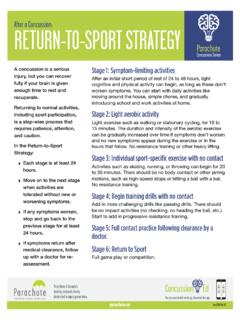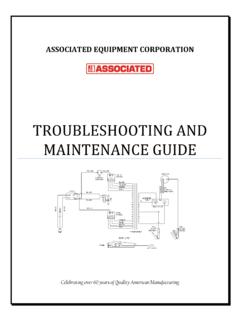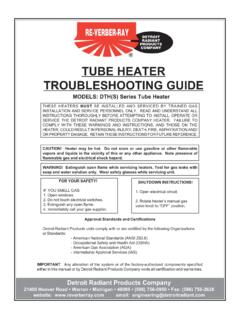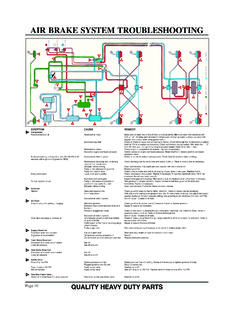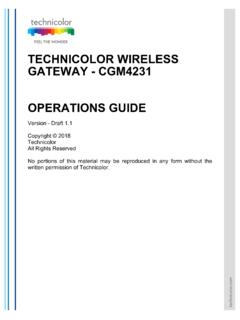Transcription of Concussion Guide for Parents and Caregivers - Parachute
1 What is a Concussion ? A Concussion is a brain injury that cannot be seen on routine X-rays, CT scans, or MRIs. It affects the way a child may think and remember things, and can cause a variety of symptoms. What are the signs and symptoms of a Concussion ? Your child does not need to be knocked out (lose consciousness) to have had a Concussion . Your child might experience one or more of the following: It is harder for infants, toddlers, and preschoolers to communicate how they are feeling. If you have a young child, you might notice any of the following: crying more than usual; unsteady walking; lack of interest in favourite toys; changes in nursing, eating or sleeping patterns; or loss of new skills, such as toilet training.
2 Get medical help immediately if your child has any red flag symptoms such as neck pain, repeated vomiting, growing confusion, seizures, and weakness or tingling in their arms or legs. These may be signs of a more serious injury. Parachute is Canada s leading national charity dedicated to injury Guide for S AND CAREGIVERSC oncussionEdFor Concussion info on the go, download the 2019-06-03 Parachute Concussion SeriesThinking ProblemsChild s ComplaintsOther Problems Does not know time, date, Headache Poor co-ordination or place, details about a recent activity General confusion Cannot remember things that happened before and after the injury Knocked out Dizziness Feels dazed Feels dinged or stunned.
3 Having my bell rung Sees stars, flashing lights Ringing in the ears balance Blank stare/glassy-eyed Vomiting Slurred speech Slow to answer questions or follow directions Sleepiness Loss of vision Easily distracted Poor concentration Sees double or blurry Stomachache, stomach pain, nausea Strange or inappropriate emotions ( , laughing, crying, getting mad easily) Not participating wellConcussion Guide for Parents and Caregivers What causes a Concussion ? Any blow to the head, face or neck, or a blow to the body which causes a sudden jarring of the head may cause a Concussion ( , a ball to the head, colliding with another person). What should I do if I suspect my child has a Concussion ?
4 In all suspected cases of Concussion , your child should stop the activity right away. Continuing increases their risk of more severe, longer-lasting Concussion symptoms, as well as increases their risk of other injury. The Concussion Recognition Tool 5 (CRT5) can be used by anyone to help recognize the signs and symptoms of a possible Concussion . Your child should not be left alone and should be seen by a doctor as soon as possible that day. If your child loses consciousness, call an ambulance to take them to the hospital right away. Do not move your child or remove any equipment such as a helmet. Your child should not return to play the same day. How long before my child gets better?
5 The signs and symptoms of a Concussion often last for one to four weeks but may last longer. In some cases, children may take many weeks or months to heal. If your child has had a Concussion before, they may take longer to heal. If your child s symptoms are persistent ( , last longer than four weeks in youth under 18 years old), they should be referred to a healthcare professional who is an expert in the management of Concussion . How is Concussion treated? After an initial short period of rest (24 to 48 hours), light cognitive and physical activity can begin, as long as these don t worsen symptoms. A medical doctor, preferably one with experience managing concussions, should be consulted before beginning step-wise Return-to-School and Return-to-Sport Strategies.
6 As your child is recovering from Concussion , they should not do any activities that may make their symptoms worse. This might mean limiting activities such as riding their bike, play wrestling, reading, working on the computer or playing video games. Recovering from Concussion is a process that takes patience. If your child goes back to activities before they are ready, it is likely to make their symptoms worse, and their recovery might take longer. When should my child go to the doctor? Anyone with a possible head injury should be seen by a doctor as soon as possible. If your child is diagnosed with a Concussion , the doctor should schedule a follow-up visit within the next one to two weeks.
7 Take your child back to the doctor immediately if, after being told they have a Concussion , they have worsening symptoms, such as: being more confused headache that is getting worse vomiting more than twice not waking up having any trouble walking having a seizure strange behaviour When can my child return to school? Your child may find it hard to concentrate in class, may get a worse headache, or feel sick to their stomach. Your child should stay home from school if being in class makes their symptoms worse. Once they feel better, they can try going back to school Guide for Parents and Caregivers part time to start ( , for half days) and if they are OK with that, then they can go back full time.
8 On average, children with Concussion miss one to four days of school. Each Concussion is unique, so your child may progress at a different rate than others. The Return-to-School Strategy provides information on the stages of returning to the classroom. Return to school must come before full return to sport. When can my child return to sport and physical activity? It is very important that your child does not go back to full participation in sport if they have any Concussion signs or symptoms. Return to sport and physical activity must follow a step-wise approach. going for a walk at recess or shooting a basketball. Your child shouldn t do any resistance training.
9 Stage 4: Begin practising with no contact (no checking, no heading the ball, etc.). Add in longer and more challenging physical activity. Start to add in resistance training (if appropriate for your child). Get clearance from a doctor before moving on to Stages 5 and 6. Stage 5: Participate in practice with contact, if your child plays a contact sport. Stage 6: Full game play or competition. The Return-to-Sport Strategy provides more information on the stages of returning to sport. In this approach: Each stage is at least 24 hours. Your child moves on to the next stage when they can tolerate activities without new or worsening symptoms. If any of your child s symptoms worsen, they should stop and go back to the previous stage for at least 24 hours.
10 Stage 1: After an initial 24 to 48 hours of rest, light cognitive and physical activity can begin, as long as these don t worsen symptoms. Your child can start with daily activities such as moving around the home and simple chores, such as making their bed. Stage 2: Light aerobic activity such as walking or stationary cycling, for 10 to 15 minutes. Your child shouldn t do any heavy lifting or resistance training ( , bodyweight exercises, weight training). Stage 3: Individual physical activity with no risk of contact for 20 to 30 minutes. Your child can participate in simple, individual activities, such as Your child should not return to sport until cleared by a doctor!
